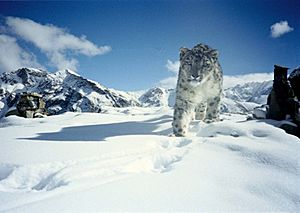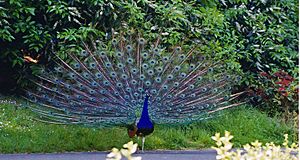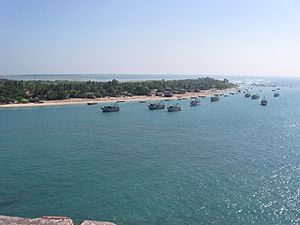Wildlife of India facts for kids
India is an amazing country with a huge variety of wild animals and plants! It's like a giant natural treasure chest, full of different places like the snowy Himalayas in the north, thick rainforests in the south, dry deserts in the west, and swampy mangrove forests in the east. India is home to about 7.6% of all mammal species, 14.7% of amphibians, 6% of birds, 6.2% of reptiles, and 6.0% of flowering plants found worldwide. Its forests are home to about 500 types of mammals and over 2000 kinds of birds. India's rich wildlife has been celebrated for a very long time. In fact, four of India’s national symbols are mammals!
India is one of the most biodiverse places on Earth. It has three of the world’s 36 "biodiversity hotspots." These are special areas with many unique plants and animals. They include the Western Ghats, the Eastern Himalayas, and the Indo-Burma hotspot. India is also one of seventeen "megadiverse countries," meaning it has a huge number of different species. The country has seven Natural World Heritage sites, eleven Biosphere Reserves, and thirty-seven Ramsar Wetlands. These are all important places for protecting nature.
To help protect its wild animals, the Indian government started creating national parks and protected areas in 1935. These efforts have grown a lot since then. In 1972, India passed the Wildlife Protection Act and started "Project Tiger." These actions were taken to save important animal homes. More laws to protect wildlife were made in the 1980s.
India also has about 2,714 types of Lichen. Lichens are like tiny plants that grow on rocks and trees. In 2020, India opened its first Lichen Park in Munsiyari, Uttarakhand.
Contents
Where India's Wildlife Comes From
Many of India's animals and plants come from an ancient supercontinent called Gondwana. India was once part of this huge landmass. Over millions of years, India slowly moved and crashed into the Asian land. This collision led to a big exchange of different species.
However, about 20 million years ago, volcanoes and climate changes caused many unique Indian species to disappear. Soon after, new mammals arrived in India from Asia. They came through two natural pathways on either side of the growing Himalaya mountains. Because of this history, only a small number of India's mammals (12.6%) and birds (4.5%) are found nowhere else. But a much larger number of its reptiles (45.8%) and amphibians (55.8%) are unique to India.
Some famous animals found only in India include the Nilgiri langur (a type of monkey) and the brown and red Beddome's toad. India is also home to 172 species that are considered threatened by the International Union for Conservation of Nature (IUCN). India is located where three major animal regions meet: Afrotropical, Indomalayan, and Paleoarctic. This mix brings many different birds to India from these areas.
Amazing Animals of India

India is famous for its large and impressive animals. You can find the mighty Indian elephant, the rare Indian rhinoceros, and big cats like the Bengal tiger, Asiatic lion, Indian leopard, snow leopard, and clouded leopard.
Other interesting animals include:
- Bears: The sloth bear, Himalayan black bear, and Himalayan brown bear.
- Deer and Antelopes: The unique chausinga, the speedy blackbuck, chinkara, chital, sambar (deer), Tibetan antelope, goa (antelope), Kashmir stag, and the barasinga (swamp deer).
- Wild Goats and Sheep: Various types of wild goats and sheep, including the Bhutan takin, Mishmi takin, Himalayan goral, red goral, Himalayan serow, red serow, Himalayan tahr, and Nilgiri tahr.
- Wild Donkeys: The kiang and Indian wild ass.
- Reptiles: Dangerous snakes like the king cobra and Indian cobra, large Indian pythons, reticulated pythons, and many types of geckos.
- Birds: The colorful Indian peacock, the huge Great hornbill, elegant painted storks, and beautiful greater and lesser flamingos.
Wonderful Plants of India
India has about 18,500 types of flowering plants! The Indian Forest Act, 1927 helped protect these natural habitats. Many special areas, like the shola forests in the Western Ghats, have many plants found nowhere else. Overall, about 33% of India's plant species are unique to the country.
India's plant life changes a lot depending on the region:
- Rainforests: In the Andaman Islands, Western Ghats, and Northeast India, you'll find lush tropical rainforests.
- Coniferous Forests: In the Himalaya mountains, there are coniferous forests with pine and fir trees.
- Deciduous Forests: In eastern India, you'll see sal trees in moist deciduous forests. Central and southern India have teak trees in dry deciduous forests.
- Thorn Forests: In the central Deccan and western Gangetic plain, there are babul trees in thorn forests.
An important Indian tree is the medicinal neem tree, often used in traditional remedies. Bamboo gardens are very common in jungles and villages. States like Sikkim and West Bengal are famous for their beautiful orchids. The national flower of India, the lotus flower, grows in many lakes and ponds.
Amazing Fungi of India
Fungi are a fascinating part of the natural world, and India has a huge variety of them! Scientists have only just begun to explore all the different types of fungi in India. About one-third of all the fungal species in the world are found here.
India has 10 different types of natural environments, from the Himalayas to deserts, coasts, and islands. These varied places allow many different fungi to grow. This includes fungi that like hot places, cold places, water, and even those that cause plant or animal diseases. There are also many edible fungi and helpful fungi. Over 27,000 species of fungi have been recorded in India. This makes them the largest group of living things after insects!
Protecting India's Wildlife
The Indian government and its citizens are committed to protecting nature. Article 48 of India's Constitution says the government should work to protect and improve the environment, forests, and wildlife. Article 51-A states that every citizen has a duty to protect and improve the natural environment, including forests, lakes, rivers, and wildlife. It also says we should be kind to all living creatures.
Even with some environmental challenges, India still has incredibly rich and diverse wildlife.
As of 2018-2019, India has 870 protected areas. These include 104 National Parks, 551 Wildlife Sanctuaries, 88 Conservation Reserves, and 127 Community Reserves. Together, they cover about 5.02% of the country's land. There are also 50 Tiger Reserves, 18 Biosphere Reserves, and 32 Elephant Reserves.
Sadly, a study over 25 years shows that hundreds of India's bird populations are shrinking.
In 2020, the Indian government created the world's first sea cucumber reserve in Lakshadweep. This is called the Dr KK Mohammed Koya Sea Cucumber Conservation Reserve. They also made the largest marine conservation reserve, the Attakoya Thangal Marine Conservation Reserve. And the first protected area for marine birds in India, the PM Sayeed Marine Birds Conservation Reserve.
Animals That Have Disappeared Recently

The Gir forest in India is the only place in the world where Asiatic lions still live in the wild. In the late 1960s, there were only about 180 Asiatic lions left. Thanks to conservation efforts, their numbers grew to over 600 in the Gir National Park by 2018!
Some bird species have sadly become extinct in recent times. These include the pink-headed duck and the Himalayan quail. A type of warbler bird, Acrocephalus orinus, was thought to be extinct for 139 years. It was only known from one specimen collected in India. But it was rediscovered in Thailand!
Wildlife in Indian Culture
India's rich and varied wildlife has deeply influenced its popular culture. Animals often appear in famous Indian stories and fables. Two well-known collections are the Panchatantra and the Jataka Tales.
The wildlife of India also became famous in the West through The Jungle Book. This popular book was written by Rudyard Kipling in the late 1800s.
India's National Animals

India has several national symbols that represent its amazing wildlife:
- National Animal: The powerful Bengal tiger.
- National Heritage Animal: The majestic Indian elephant.
- National Aquatic Animal: The unique South Asian river dolphin.
- National Bird: The colorful Indian peacock.
Special Biosphere Reserves

The Indian government has set up eighteen Biosphere Reserves. These are large protected areas that include national parks and other reserves. They also have "buffer zones" where some human activities are allowed. These reserves protect not only the plants and animals but also the human communities living there and their ways of life.
Some of India's Biosphere Reserves are:
- Achanakmar Wildlife Sanctuary
- Agasthyamala Biosphere Reserve
- Dibru-Saikhowa National Park
- Dihang-Dibang Biosphere Reserve
- Great Nicobar Biosphere Reserve
- Gulf of Mannar Marine National Park
- Kutch Desert Wildlife Sanctuary
- Khangchendzonga National Park
- Manas National Park
- Nanda Devi National Park
- Nilgiri mountains
- Nokrek National Park
- Pachmarhi Biosphere Reserve
- Simlipal National Park
- Sundarbans National Park
- Cold Desert
- Seshachalam hills
- Panna National Park
Eleven of these eighteen Biosphere Reserves are part of the World Network of Biosphere Reserves. This is a special list created by UNESCO to highlight important natural sites around the world.
These include:
- Gulf of Mannar Biosphere Reserve
- Nanda Devi Biosphere Reserve
- Nilgiri Biosphere Reserve
- Nokrek National Park
- Pachmarhi Biosphere Reserve
- Simlipal National Park
- Sundarbans Biosphere Reserve
- Achanakmar-Amarkantak Biosphere Reserve
- Nicobar Islands
- Agasthyamala Biosphere Reserve
- Khangchendzonga


